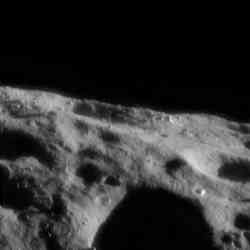
Asteroid 433 Eros taken by NEAR Shoemaker. Image credit: NASA. Click to enlarge
An asteroid’s external features, when analyzed carefully, can say a lot about its interior. So it was while he was mapping the surface of asteroid 433 Eros that Peter Thomas, a senior research associate in astronomy at Cornell University, found a simple solution to an earlier puzzle about the asteroid’s composition.
Thomas was using images collected by the Near Earth Asteroid Rendezvous mission in 2001 to create a digital map of Eros. On the asteroid’s surface, predictably pock-marked with thousands of craters accumulated from impacts over its lifetime, he saw a feature first noticed by Cornell graduate student Marc Berthoud: that a few particular patches were inexplicably smooth. That observation had led to various theories — but none that seemed completely satisfying.
In a letter appearing in the current issue of the journal Nature (Vol. 436, No. 7049, p. 366), Thomas and Northwestern University geologist Mark Robinson show that the asteroid’s smooth patches can be explained by a seismic disturbance that occurred when the crater, known as the Shoemaker crater, was formed.
The fact that seismic waves were carried through the center of the asteroid shows that the asteroid’s core is cohesive enough to transmit such waves, Thomas says. And the smoothing-out effect within a radius of up to 9 kilometers from the 7.6-kilometer Shoemaker crater — even on the opposite side of the asteroid — indicates that Eros’ surface is loose enough to get shaken down by the impact.
Asteroids are small, planetlike bodies that date back to the beginning of the solar system, so studying them can give astronomers insight into the solar system’s formation. And while no asteroids currently threaten Earth, knowing more about their composition could help prepare for a possible future encounter.
Eros, whose surface is a jumble of house-sized boulders and small stones (“what geologists call ‘poorly sorted,'” says Thomas), is the most carefully studied asteroid, in part because its orbit brings it close to earth.
Thomas and Robinson considered various theories for the regions of smoothness, including the idea that ejecta from another impact had blanketed the areas. But they rejected the ejecta hypothesis when calculations showed an impact Shoemaker’s size wouldn’t create enough material to cover the surface indicated. And even if it did, they add, the asteroid’s irregular shape and motion would cause the ejecta to be distributed differently.
In contrast, says Thomas, the shaking-down hypothesis fits the evidence neatly. “The classic light bulb goes on in your head,” he says; the crater density of small craters increases with the distance from the Shoemaker crater. “Simple geometry says something like a simple seismic wave.”
The NEAR mission, in which a NASA spacecraft landed on the asteroid’s surface in 2001 after orbiting it for a year, yielded more than 100,000 images of the small asteroid. (Eros is about 33 kilometers long, 13 kilometers wide and 8 kilometers thick). Since the mission’s conclusion 16 days after the landing, scientists from institutions around the world have been sorting through the data.
That process is expected to continue for years. “Careful mapping of things on the surface can give you a good clue as to what’s inside,” says Thomas. “And in one sense, we’ve barely begun.”
Original Source: Cornell University News Release
